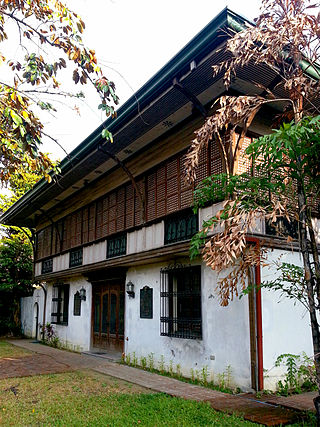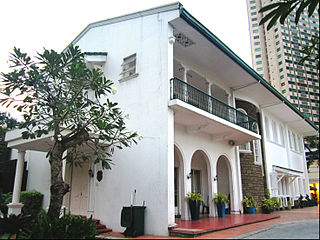
María Corazón"Cory" Sumulong Cojuangco-Aquino was a Filipino politician who served as the 11th president of the Philippines from 1986 to 1992. She was the most prominent figure of the 1986 People Power Revolution, which ended the two-decade rule of President Ferdinand Marcos and led to the establishment of the current democratic Fifth Philippine Republic.

José Paciano Laurel y García was a Filipino politician, lawyer, and judge, who served as the President of the Second Philippine Republic from 1943 to 1945, which was a Japanese ally during World War II. Since the administration of President Diosdado Macapagal (1961–1965), Laurel has been officially recognized by later administrations as a former president of the Philippines.

José Sotero Hidalgo Laurel III, was a Filipino diplomat and the aide-de-camp of President Jose P. Laurel during the World War II period. He later became ambassador of the Philippines to Japan.

Miguel Malvar y Carpio was a Filipino general who served during the Philippine Revolution and, subsequently, during the Philippine–American War. He assumed command of the Philippine revolutionary forces during the latter, following the capture of resistance leader Emilio Aguinaldo by the Americans in 1901. According to some, he could have been listed as one of the presidents of the Philippines. However, is not recognized as such by the Philippine government.

Josefa Madamba Llanes Escoda was a Filipino civic leader, social worker, World War II heroine, and suffragette. Recognized as the "Florence Nightingale" of the Philippines for her contributions to social work, as she displayed great courage and dedication through her initiatives for campaigning for women's suffrage and as a founder of the Girl Scouts of the Philippines.

Aurora Antonia Aragon Quezon was the wife of Philippine President Manuel Luis Quezon and the First Lady of the Philippines from 1935 to 1944. Although she is recognized as the second First Lady of the Philippines, she was actually the first spouse of a Philippine president to be addressed as such, the honorific being unknown in the Philippines prior to Manuel Quezon's presidency. Much beloved by Filipinos, Quezon was known for involvement with humanitarian activities and served as the first chairperson of the Philippine National Red Cross.

Salvador Roman Hidalgo Laurel, also known as Doy Laurel, was a Filipino lawyer and politician who served as the Vice President of the Philippines from 1986 to 1992 under President Corazon Aquino and briefly served as the last Prime Minister from February 25 to March 25, 1986, when the position was abolished. He was a major leader of the United Nationalist Democratic Organization (UNIDO), the political party that helped topple the regime of President Ferdinand Marcos with the 1986 People Power Revolution.

The first lady or first gentleman of the Philippines is the courtesy title given to the host or hostess of Malacañang Palace, the residence of the head of state and head of government of the Philippines.

Benigno Simeón Aquino y Quiambao was a Filipino politician who served as speaker of the National Assembly of the Japanese-sponsored puppet state in the Philippines from 1943 to 1944. He was the Director-General of KALIBAPI, a political party established during the Japanese occupation of the Philippines.

The Manila North Cemetery is one of the oldest cemeteries in Metro Manila, Philippines. The cemetery is owned by and located in the City of Manila, the national capital, and is one of the largest in the metropolis at 54 hectares. It is located alongside Andrés Bonifacio Avenue and borders two other important cemeteries: the La Loma Cemetery and the Manila Chinese Cemetery. Numerous impoverished families notably inhabit some of the mausoleums.

The Nacionalista Party is a political party in the Philippines and the oldest in the country and in Southeast Asia. It is responsible for leading the country throughout most of the 20th century since its founding in 1907; it was the ruling party from 1935 to 1946, 1953–1961 and 1965–1978.

The Knights of Rizal is an order of chivalry of the Philippines, created to honor and uphold the ideals of Philippine national hero José Rizal. Knighthood confers a personal title (Sir) and this status, as well as any professional affiliation to the Order, is protected by law against impersonation or fraud. The insignia of the Knights of Rizal is ranked seventh in the Order of Wear pursuant to the Implementing Rules and Regulations of the Honors Code of the Philippines, and is often worn by members of the Philippine government and diplomatic corps.

The Four Day Revolution is a 1988 Australian television film directed by Robert Markowitz and written by David Williamson. The story is about the journey and the love affair of an American foreign correspondent set during the final years of Ferdinand Marcos' dictatorship in the Philippines, from the assassination of Benigno Aquino Jr. in 1983 to the People Power Revolution in 1986, as well as other key events that led to the ouster of Marcos.

The Kapisanan sa Paglilingkod sa Bagong Pilipinas, or KALIBAPI, was a fascist Filipino political party that served as the sole party of state during the Japanese occupation. It was intended to be a Filipino version of Japan's governing Imperial Rule Assistance Association.
Arsenio "Dodjie" Hidalgo Laurel was a champion race car driver from the Philippines. He was the first two-time winner of the Macau Grand Prix, winning it consecutively in 1962 and 1963.

José Bayani "Pepito" Hidalgo Laurel Jr., also known as Jose B. Laurel Jr., was a Filipino politician who was elected twice as speaker of the House of Representatives of the Philippines. A stalwart of the Nacionalista Party, he was the party's candidate for the country's vice president in the 1957 elections.

Sotero Cosme "Teroy" Hidalgo Laurel II was a Filipino politician and educator who served as a Senator from 1987 until 1992, including a period as President pro tempore from 1990 until 1991. Laurel was the son of the former President of the Philippines José P. Laurel and the older brother of former Vice President Salvador Laurel. Laurel was nicknamed "Teroy."

The Jose P. Laurel Ancestral House is a historic house in Manila, Philippines. It is one of the three houses owned by the President of the Second Philippine Republic, José P. Laurel. It is located in 1515 Peñafrancia Street in Paco District. President Laurel purchased the house in 1926 and served as his residence, together with his wife Pacencia Hidalgo and their children, for 29 years before he transferred to his retirement home in Mandaluyong.

The Jose P. Laurel Residence, also known as Villa Pacencia and Laurel Mansion, is a historic house located at 515 Shaw Boulevard in Mandaluyong, Metro Manila. The three-story house was built in 1957 and was one of the three houses owned by the President of the Second Republic of the Philippines, José P. Laurel.
The Laurel family is a Filipino family of politicians and entertainers.


















